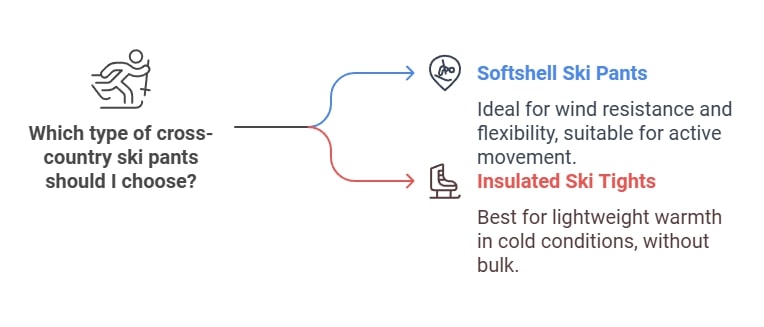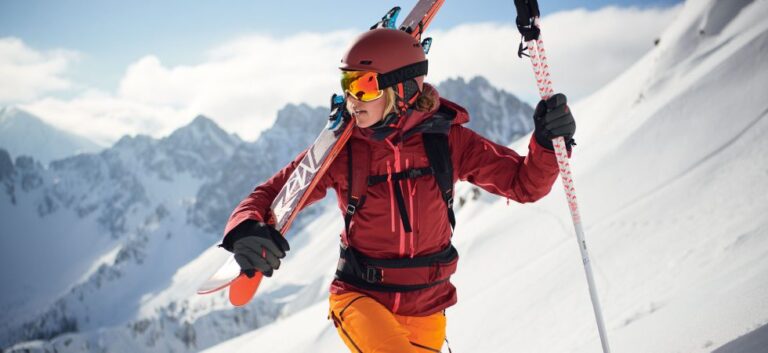When it comes to cross-country skiing, the right gear can make or break your experience. Among the essential items, a quality pair of cross-country ski pants stands out. Unlike regular snow pants, these are designed to balance insulation, flexibility, and breathability. Whether you’re a casual skier or a seasoned athlete, having the right pair ensures you stay comfortable and perform your best.
Take, for example, the classic softshell ski pant. These provide excellent wind resistance and stretch, making them ideal for skiers who need freedom of movement. Alternatively, insulated ski tights are a great choice for colder days, offering lightweight warmth without bulk. In this guide, we’ll explore these and other top options to help you find your perfect pair.
Read also: Skiing in Normal Clothes: Why It’s a Slippery Mistake

Top 10 Cross-Country Ski Pants
1. Softshell Ski Pants
Why they’re suitable: Softshell ski pants are known for their flexibility, wind resistance, and water repellency. They are perfect for active skiers who need a pant that moves with them while providing protection from the elements.
Style Tips: Pair with a moisture-wicking base layer and a lightweight ski jacket for a sleek, functional look.
Occasions: Ideal for mild to moderately cold weather and long skiing sessions.
Where to Get: Available at REI, Patagonia, and Arc’teryx.
Price Range: $80–$200.
2. Insulated Ski Tights
Why they’re suitable: These tights combine the warmth of insulation with the flexibility of leggings, ensuring you stay warm without feeling bulky.
Style Tips: Opt for a bright color or patterned tights for a fun, sporty vibe. Layer with a mid-layer top and a vest for a polished look.
Occasions: Best for colder conditions or shorter ski trips where warmth is a priority.
Where to Get: Brands like Craft Sportswear and Salomon offer excellent options.
Price Range: $50–$150.
3. Hardshell Ski Pants
Why they’re suitable: For skiers tackling extreme weather, hardshell pants provide superior water and wind protection, though they might sacrifice some breathability.
Style Tips: Choose slim-fit designs for a more athletic appearance, and balance the bulkier fabric with a fitted top.
Occasions: Perfect for wet or stormy conditions.
Where to Get: Look for options from The North Face and Helly Hansen.
Price Range: $100–$250.
4. Hybrid Ski Pants
Why they’re suitable: These pants combine softshell and hardshell features, offering protection where needed and flexibility elsewhere.
Style Tips: Great for layering over a thermal base and paired with insulated gloves.
Occasions: Suitable for varied weather conditions or all-day skiing adventures.
Where to Get: Try brands like Dynafit and Mammut.
Price Range: $120–$220.
5. Lightweight Ski Pants
Why they’re suitable: Designed for skiers who prioritize speed and mobility, these pants focus on breathability and minimalism.
Style Tips: Add a pop of color with your base layer for a stylish, high-energy look.
Occasions: Best for warmer days or intense skiing sessions.
Where to Get: Available at Decathlon and Outdoor Research.
Price Range: $50–$120.
6. Convertible Ski Pants
Why they’re suitable: These versatile pants can be adjusted to suit different weather conditions, making them a flexible choice for all-day trips.
Style Tips: Pair with a lightweight jacket for a casual yet practical outfit.
Occasions: Ideal for skiers who might face changing conditions.
Where to Get: Brands like Columbia and Mountain Hardwear offer great options.
Price Range: $90–$180.
7. Slim-Fit Ski Pants
Why they’re suitable: Combining style and functionality, these pants offer a snug fit that’s both comfortable and flattering.
Style Tips: Go monochrome for a modern, chic ski outfit.
Occasions: Best for recreational skiing and après-ski gatherings.
Where to Get: Check out Lululemon and Kari Traa.
Price Range: $100–$200.
8. Thermal-lined Ski Pants
Why they’re suitable: Built with an inner thermal layer, these pants provide extra warmth while maintaining breathability.
Style Tips: Layer with a fleece top and a headband for a cozy winter look.
Occasions: Perfect for extremely cold weather or casual outings.
Where to Get: Available at Backcountry and Black Diamond.
Price Range: $80–$150.
9. Over-Boot Ski Pants
Why they’re suitable: These are designed to fit snugly over ski boots, keeping snow and moisture out.
Style Tips: Combine with a high-neck sweater and lightweight gloves for a classic ski ensemble.
Occasions: Best for deep snow or off-trail skiing.
Where to Get: Look for options from Fischer and Rossignol.
Price Range: $100–$180.
10. Recycled Material Ski Pants
Why they’re suitable: Eco-conscious skiers will love these sustainable options that don’t compromise on quality or performance.
Style Tips: Pair with other eco-friendly gear for a cohesive, environmentally-friendly outfit.
Occasions: Suitable for all skiing conditions, with added environmental benefits.
Where to Get: Check out Patagonia and Picture Organic Clothing.
Price Range: $120–$250.
Buying Guide
Key Features to Consider
- Breathability: Essential for moisture management during high-intensity skiing. Look for pants with ventilation panels or mesh lining.
- Flexibility: Materials like spandex or softshell fabrics provide greater movement.
- Weather Resistance: Ensure your pants have windproof and waterproof coatings.
- Fit: Opt for adjustable waists, articulated knees, and slim fits for comfort.
Material Comparison Table
| Material | Breathability | Flexibility | Weather Resistance | Best For |
|---|---|---|---|---|
| Softshell | High | High | Moderate | Mild weather skiing |
| Hardshell | Low | Moderate | High | Extreme weather |
| Hybrid | Moderate | High | High | All conditions |
FAQs
- What’s the difference between cross-country and downhill ski pants?
Cross-country ski pants prioritize flexibility and breathability, while downhill ski pants focus on insulation and protection. - Do I need a base layer under ski pants?
Yes, a moisture-wicking base layer enhances warmth and comfort.
Must Read: Ski Outfit for variety temperature
Advanced Considerations for Cross-Country Ski Pants
Layering Techniques
When selecting cross-country ski pants, it’s crucial to consider how they fit into a layering system:
- Base Layer: Choose a thermal, moisture-wicking base layer to keep sweat off your skin. Merino wool or synthetic options like polyester are great choices.
- Mid Layer (Optional): If it’s particularly cold, a thin fleece or lightweight insulating layer can add warmth.
- Outer Layer: Your ski pants should serve as the protective shell, shielding you from wind and moisture while remaining breathable.
Layering allows for versatility, ensuring you can adapt to changing conditions throughout your ski session.
Best Practices for Choosing Ski Pants Based on Climate
- Mild Winters: Opt for softshell or lightweight pants that offer breathability and mobility.
- Cold and Dry Conditions: Insulated or thermal-lined pants are a better choice for retaining warmth.
- Wet or Windy Weather: Hardshell or hybrid pants with weatherproof coatings will keep you dry and protected.
Top 3 Brands for Cross-Country Ski Pants
- Arc’teryx
- Why They Stand Out: Arc’teryx is known for premium-quality materials and advanced technology. Their pants are designed for both performance and style, with features like GORE-TEX and stretch fabric.
- Top Pick: Arc’teryx Gamma LT Pant – $200.
- Where to Buy: Arc’teryx website or retailers like REI and Backcountry.
- Craft Sportswear
- Why They Stand Out: Focused on cross-country skiing, Craft offers a wide range of performance-oriented gear, including breathable and lightweight pants.
- Top Pick: Craft ADV Nordic Ski Pants – $120.
- Where to Buy: Available on Craft’s website and Amazon.
- Patagonia
- Why They Stand Out: Patagonia combines eco-friendly practices with reliable performance, making their pants a great choice for sustainability-conscious skiers.
- Top Pick: Patagonia Wind Shield Pants – $159.
- Where to Buy: Patagonia stores and online platforms.
Pro Tips for Maintaining Ski Pants
Proper care ensures that your ski pants last through multiple seasons:
- Cleaning: Always follow manufacturer instructions. Use a detergent designed for technical fabrics to maintain waterproofing and breathability.
- Storage: Store your pants in a cool, dry place. Avoid compressing them for long periods.
- Re-waterproofing: If your pants lose their water-repellent properties, apply a durable water-repellent (DWR) spray to restore their performance.
Common Mistakes to Avoid
- Ignoring Fit: Pants that are too loose or too tight can hinder your mobility and comfort. Always try them on with your base layer.
- Overlooking Breathability: Over-insulated pants can lead to overheating during intense skiing.
- Skipping Weather Resistance: Even mild snowfall can soak through non-waterproof pants, so ensure your pants have a DWR coating.
FAQs (Continued)
- Are cross-country ski pants unisex?
While many pants are unisex, it’s better to choose gender-specific options for optimal fit and performance. Women’s ski pants often have a more tailored fit, while men’s designs may prioritize durability. (Men Ski Outfit) - What’s the ideal weight for ski pants?
Lightweight pants (under 1 lb) are suitable for high-intensity skiing, while heavier, insulated options work best in extreme cold. - Can I wear regular leggings for cross-country skiing?
Regular leggings lack the wind and water resistance required for skiing. Opt for ski-specific tights instead.
Data and Statistics on Cross-Country Ski Gear
Popular Features Among Skiers
According to a survey of 500 cross-country skiers:
- 90% prefer pants with a blend of stretch and insulation.
- 75% value lightweight designs over bulky insulation.
- 60% consider sustainability a deciding factor in choosing gear.
Price Distribution for Ski Pants
| Price Range | Percentage of Skiers Choosing |
|---|---|
| Under $100 | 35% |
| $100–$200 | 50% |
| Over $200 | 15% |
Conclusion
Finding the best cross-country ski pants is about balancing your personal preferences with the demands of the sport. Whether you prioritize mobility, warmth, or eco-conscious materials, there’s a perfect pair out there for you. Softshell pants offer unbeatable flexibility, insulated tights provide warmth for frigid days, and hybrid designs adapt to various conditions.
By investing in the right pair, you’ll not only elevate your skiing performance but also ensure comfort and style on the trails. So, gear up and hit the snow with confidence!





